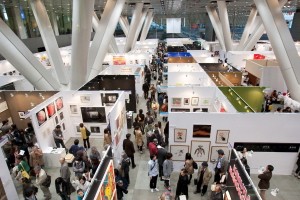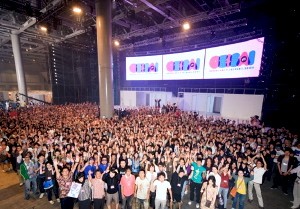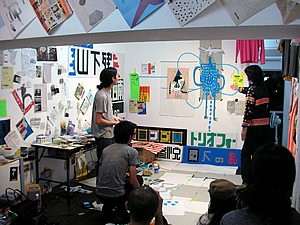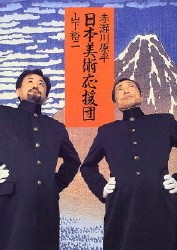– With special reference to Murakami Takashi’s GEISAI, Mori Yoshitaka’s ideology of the street, and Akasegawa Genpei and Yamashita Yuji’s Nihon Bijutsu Oendan cheerleaders for Japanese art
by Sawaragi Noi
The brief was to take a retrospective look at 2009, but with the ‘noughties’ ending and the ‘twenty-tens’ beginning, naturally it struck me that 2009 also marked the end of the first decade of the 21st century. Making this the ideal opportunity to reflect on not just one year in the Japanese art world, but the past ten.

Art Fair Tokyo 2009
© Art Fair Tokyo, photo Iwashita Munetoshi
To begin, on the one hand what comes to mind is how Japan’s art sector caught a worldwide wave of market activity, in the process gaining an unprecedented public profile and generating a massive media response. With specialist terms such as ‘biennale’ gaining common currency, and the staging of a series of similar large-scale events in locations around the world, the hitherto rather rarefied international art show scene acquired the aspect of a touring circuit set up to handle legions of artists, exhibitions starting to resemble art (trade) fairs with their multiple booths. Where once the talk was of an ‘age of the curator’, by the second half of the 2000s it was instead a new generation of ‘gallerists’ – as opposed to the somehow shady-sounding ‘art dealers’ of the past – that stepped confidently into the limelight. For example, there is nothing unusual now about appointing gallerists to art-judging panels, but in the past this would have been unthinkable. In the end, regardless of job titles, the fact remains that for these folks, art is business. Artists’ names and their output are subject to constant market appraisal and unavoidable speculation, and it is only very recently that a portion of these works (regardless of what they were) were breaking records for ‘the highest prices in art history’ with almost monotonous regularity.
 GEISAI #11 2008
GEISAI #11 2008photo_miget
Amid this frenzy of activity however, Japan stood out for the failure of either international art shows or fairs to take root in any kind of systematic fashion. Rather it was Murakami Takashi’s GEISAI, an alternative path and attempted divergence from the Western art fair model, that despite being derided from the start as ‘little more than a street bazaar’ ultimately must be credited with unearthing more unknown talent than any officially sanctioned biennale, triennale, art prize or suchlike, and offering these up-and-coming artists real opportunities
On the other hand were the 9/11 attacks on the United States at the start of the decade, the shock of which cast an invisible cloud over not just the art sector but the world as a whole from whose lingering effects we have yet to recover. When the impact of 9/11 is factored in, the aforementioned sudden soaring of the art market starts to resemble an opaque veil, a cultural camouflaging of a widespread unease that could perhaps be described as a fissure [NOTE In what? Doesn’t a crack have to be in something? Society? The social fabric?]. Added to this is a new emphasis on security since 9/11, particularly in the major cities of the West, which has resulted in a public arena originally belonging to the many suddenly crammed with CCTV cameras and recast as a controlled space accessible to none. For instance, in the ’90s the street was the only alternative venue in Japan; galleries, museums and events such as biennials and art fairs being still underdeveloped, and it wouldn’t have occurred to anyone to be suspicious of this. Moreover, past groundbreaking Japanese contemporary art movements such as Gutai, Hangeijutsu (anti-Art), Mono-ha and Neo-pop without exception have their origins on the street, or elsewhere in the public arena. Thus it would be no exaggeration to assert that if Japanese art lost the street, it would be deprived of its entire inheritance, its very foundations. The hype surrounding events such as biennials and art fairs seems to have served in the past decade to shore up such sterility. The fact is that the rather curious revival in the fortunes of painting over the last ten years – compared to the ’90s – is not so much due to a emergence of new possibilities in painting as the simple fact that paintings are, as a product, easier to offload. It is also consistent with the way art prices have spiraled, in turn consistent with the worldwide ramping up of security in urban areas.
 Installation view of Yamashita Hikaru: Big Choroizm Panorama World 2008, Gallery Maki
Installation view of Yamashita Hikaru: Big Choroizm Panorama World 2008, Gallery MakiReturning to the issue of heightened security, in a sense it was probably inevitable that the ideology of the street, which deliberately seeks opposing cultural value in the street – since this new emphasis on security an inviolable (or illegal) place – would join forces with art and rise up in an attempted renewal of the practical/social context, a definitive parting of the ways with the intellectually grounded ‘left-wing’. The emergence over the decade of practitioners such as Woda Masanori a.k.a. Illcommonz – whom leading advocate of this movement Mori Yoshitaka has dubbed a ‘street philosopher’ – and Koenji-based collective Shiroto no Ran, which while clearly delineated from both previous ‘artists’ and members of the ‘left-wing’ combine elements of both, should be understood in this context.
However, the art of the street (not referring to graffiti and its ilk) was a ubiquitous feature of the landscape in post-war Japanese contemporary art, and we should never forget that it is the street that consistently created the circumstances for art to exist even divorced from political and social context. In short, there is nothing ‘new’ about the notion of street art. On the contrary, in a way it is actually the natural order of things; and, it’s worth recalling, where it all began (for example, Japan’s first exhibition of Western oil paintings was staged in the Meiji years by Goseda Horyu in the grounds of Senso-ji Temple), without any need to cosy up to political interests. In this vein, Chim↑Pom, for example, by flying a Cessna over Hiroshima to skywrite characters meaning ‘blast’ (referring to the moment the atomic bomb was dropped) and sparking enormous controversy in the process, may have come across as typical ’00s generation artists, but in reality such actions are a subtle divergence from the notion of art as activism, or any sort of street ideology. For example, even if Chim↑Pom did attract ‘political’ comment, this was not due to any ideology they possess, but rather the absence of one. Come to think of it, this may be the standard form adopted by Japanese art in the maelstrom of urban life since modernization, the only option available. Which is why Chim↑Pom’s potential must be perceived not in any fleeting shock value, but in the context of that tradition.
 Akasegawa Genpei, Yamashita Yuji Nihon Bijutsu Oendan 2000, publisher Nikkei BP Co., Ltd.
Akasegawa Genpei, Yamashita Yuji Nihon Bijutsu Oendan 2000, publisher Nikkei BP Co., Ltd. Also deserving mention for generating a buzz in the noughties was the renewed popularity of Japanese art in general. This can be attributed (as I’ve touched on before elsewhere NOTE where? Cut?) to the restructuring of administrative bodies that previously managed artworks not as assets for viewing but as ‘cultural properties’, forcing them to become financially self-sustaining and leading to widespread ‘dusting off’ of their collections, combined with other factors such as the growth in domestic tourism following 9/11. But whatever the reasons, that some of the finest examples of Japanese art, hitherto hidden away, are now accessible to all is highly significant. With this development, the Nihon Bijutsu Oendan founded by Akasegawa Genpei and Yamashita Yuji, distancing themselves slightly from the Japanese overemphasis on Western art, could be said to have served its initial purpose (these days Western art being more likely in need of ‘oen’ [cheerleading/support]). This renewed appreciation of Japanese art is expected to continue in the 2010s. Christian culture, after all, was originally someone else’s way of doing things, so the stamp of officially sanctioned culture bestowed on places where the Buddhist waft of incense sits more comfortably will not fade that easily. It must also be time to start slowly withdrawing from the habit of ‘calling good things good as a matter of course’ (for example, to recognize that even if we feel the Statue of Ashura at Kofuku-ji Temple to be every bit as marvelous as its reputation suggests, it still offers not one iota of intellectual stimulation or adventure). This is one idea worth taking to heart, if nothing else.
Why – because art’s greatest potential lies in one thing: being ‘persuaded’ by objects with which we have no previous history, for which we have no guarantees, entirely by our own senses. Art never has been, and never will be, any more than this.
←Back to Index “Feature: Contemporary art in 2009 and 2010”
